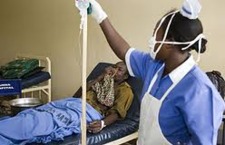|
Emergency physicians are frequently confronted by a wide array of infections,
from trivial upper respiratory viral infections to life threatening necrotizing
soft tissue infections. Emergency department (ED) patients are also diverse, ranging
from septic neonates to febrile travelers from foreign countries. Potentially
life-threatening infections must be identified early and appropriate antimicrobial
therapy initiated promptly. This section reviews specific infectious diseases issues in
the ED. Certain individual diseases are covered in detail in other chapters.
Sepsis
Definition
- Sepsis, septic shock, and sepsis syndrome are terms that have been used interchangeably.
Specific terminology has been adapted in both research and clinical settings to
strictly define these conditions. (Table 11.1)
Epidemiology
- Despite improvements in antimicrobial therapy and critical care techniques, the mortality
of patients with sepsis remains approximately 35%. The incidence of sepsis and
septic shock, continues to rise due to increasing numbers of elderly and
immunocompromised patients, more frequent use of invasive procedures and devices,
and the development of antimicrobial resistance among common bacterial pathogens.
| Table: Definitions |
|---|
 Systemic inflammatory response syndrome (SIRS) - two or more of the following:
Systemic inflammatory response syndrome (SIRS) - two or more of the following:
Temperature >38� C or < 36� C
Heart rate >90 beats/min
Respiratory rate >20 breaths/min or pCO2 < 32 mm Hg
White blood cell count >12,000 cells/mm3 or < 4,000 cells/mm3
or >10% immature neutrophils
Sepsis
SIRS with a confirmed infectious etiology
Severe Sepsis
Sepsis with hypotension or systemic manifestations of hypoperfusion
(i.e., lactic acidosis, oliguria, altered mental status)
Septic Shock
Severe sepsis despite adequate fluid resuscitation
From: American College of Chest Physicians/Society of Critical Care Medicine Consensus
Conference: Definitions for sepsis and organ failure and guidelines for the use of innovative
therapies in sepsis. Crit Care Med 1992; 20(6):866, with permission.
|
Diagnosis and Evaluation
- Historical data should be obtained from the patient and/or any other available source.
Important factors include recent hospitalizations, invasive procedures, antibiotic usage,
recent travel, and vaccinations as well as past history of unusual infections or immunosuppressive
diseases or medications.
- A thorough physical examination should be performed with an emphasis on identification
of a possible site of infection, evaluation for organ system dysfunction, and
evidence of hypoperfusion.
- Laboratory analysis should include white blood cell count with differential, hemoglobin,
platelet count, serum chemistry profile, protime/partial thromboplastin time, serum
lactate, urine analysis, and arterial blood gases.
- Blood, urine, and sputum should be collected and cultured. Material for culture should
ideally be obtained prior to antimicrobial therapy. However, the administration of
antibiotics should never be delayed.
- A chest radiograph should be obtained.
- Additional studies are warranted as dictated by the clinical scenario, such as computed
tomography (CT) of the abdomen and lumbar puncture.
ED Management
- If a patient is suspected of having severe sepsis or septic shock, initial treatment priorities
are directed to reverse life-threatening abnormalities. The patient�s airway, breathing
and circulation must be quickly established and maintained.
- Endotracheal intubation
- May be required to protect the airway, deliver increased oxygen concentrations, or
reduce the work of breathing.
- Hypotension
- Requires aggressive intravascular fluid resuscitation with crystalloids. Vasopressor
therapy (dopamine, dobutamine and norepinephrine) must be considered for persistently
low mean arterial blood pressures despite fluid resuscitation. Urine output
should be closely monitored as a measure of adequate volume resuscitation.
- Antimicrobial therapy must be instituted early. Antibiotic selection in the ED must be
empiric because it is often not possible to identify the responsible organism(s) with certainty.
This selection depends upon the presumed site of infection, the results of Gram
stains, resistance patterns of common pathogens, as well as patient factors such as allergies,
renal/hepatic dysfunction, immune status, and history of recent hospitalization. General
guidelines for severe sepsis without an identifiable source are defined in Table 11.2. If
anaerobic pathogens are likely, then metronidazole or clindamycin should be added.
Imipenem, a carbapenem with broad spectrum coverage, may be used as a single agent.
None of the above antibiotic regimens is effective against methicillin-resistant Staphylococcus
aureus (MRSA). If MRSA is suspected (e.g., the presence of an indwelling
vascular catheter) vancomycin should be added.
- Steroids have not been demonstrated to improve outcome.
| Table: Empiric antibiotics for severe sepsis without a source |
|---|
Anti-pseudomonal cephalosporin (ceftazidime or cefepime)
OR
Anti-pseudomonal penicillin (ticarcillin/clavulanate or piperacillin/tazobactam)
WITH
Aminoglycoside (gentamycin or tobramycin)
OR
Fluoroquinolone |
- Patients should be admitted to an appropriate level of care based on their clinical
stability and ongoing therapeutic needs.
|